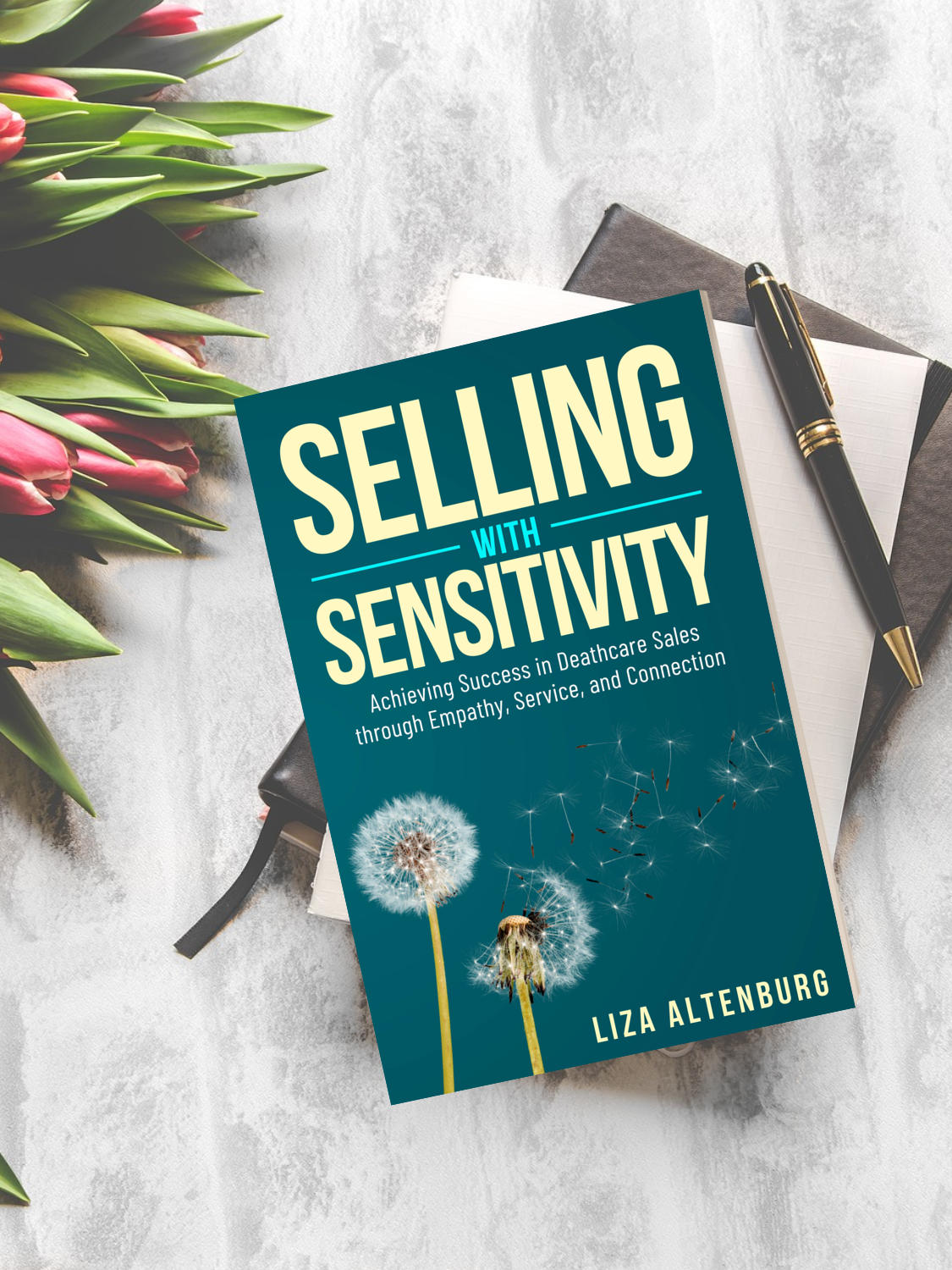Written as a guest blog for CANA and originally posted at https://www.cremationassociation.org/blogpost/776820/492807/The-Double-Edged-Sword-of-Technology-in-Deathcare-Sales
_____
Hold onto your smartwatches, folks. Here comes a potentially scandalous statement:
Not everything in our lives benefits from being Uber-ized or given the “there’s an app for that” treatment. Case in point? Deathcare sales.
Yes, I know. In an age where even our refrigerators have Wi-Fi and Alexa can tell you a joke when you’re feeling down (though, let’s be honest, some of her jokes are rather… refrigerated), here I am, diving into a topic that might make some tech enthusiasts raise an eyebrow. “Whoa, is she really about to go there? Bold statement, Altenburg!”
Emotion Over Logic: Why Deathcare Sales Isn’t Like Buying Sneakers on Amazon
End-of-life planning is far from your average purchase. It’s not about snagging a deal during a Black Friday sale or choosing between iPhone models. We’re diving deep into the realms of mortality, legacy, and the deep love we have for those we’ll someday leave behind.
So, before you start building holograms of funeral planners or virtual reality cemetery tours into your business plan, remember: this purchase is driven by raw, unfiltered emotion, not by how snazzy the tech might seem.
A Cautionary Tale: The Perils of Too Much Tech
Allow me to share a true story of a top-selling Counselor who for years rode the crest of success but this year, got a little too cozy with his tech gadgets. He crunched the numbers and thought, “Why settle for three face-to-face meetings in a day when I can chat with 15 people electronically in the same timeframe?”
He took the plunge. Instead of his usual in-person consultations, he dove into emails, texts, and Facebook messages. From 15 weekly face-to-face presentations, he plummeted to less than five, so that he could focus on his electronic ‘presentations’, which shot up to over 60 per week.
He was presenting to more people than he had before… So he sold more and earned more, right?
Wrong.
It wasn’t a mere dip in sales; it was what I would refer to as a screeching halt. His stellar five-figure contract average came crashing down to below two grand, and his average contracts-written-per-month decreased by 60%.
If you’re a commission-based salesperson, you probably felt the punch in your gut just reading those statistics.
The Counselor wasn’t just broke, he was genuinely perplexed. “These families seem so interested in our emails,” he’d lament during our meetings. “Why don’t they finalize things? Why aren’t they following through?”
In his quest for efficiency, our Counselor had become just another blip on the digital radar, another ping among the ceaseless barrage of notifications that his potential clients received daily.
Gone was the opportunity to really understand them, to discover the stories behind their eyes, or to grasp the weight of their decisions about end-of-life care. In eschewing face-to-face interactions, he’d unknowingly snuffed out the chance for genuine human connection. With this disconnect, the emotional motivation that once drove his clients to act in the best interests of their loved ones evaporated.
The Siren Call of Technology vs The Undeniable Charm of a Real, Live Human Being
With everything from our toasters to our toothbrushes getting smart upgrades, it’s certainly easy to be sold on the idea that tech is the magic pill for all industries. And yes, Zoom meetings, e-signatures, and digital brochures have their perks.
But, beware of the digital rabbit hole.
Where a new smartphone, car, or astronaut-designed pair of sneakers might be sold through slick online ads, the intricacies of deathcare sales need a different touch.
Something warmer.
More human.
There’s no app that can replicate the comfort of a reassuring hand on the shoulder, the understanding in a compassionate gaze, or the vulnerability shared in a heartfelt story by an end-of-life expert and guide (ahem, that’s you).
Face-to-face discussion is the arena where the magic happens in our field.
These interactions allow for that deep emotional connection; they keep the focus on the very human reasons for end-of-life decision-making, and frankly, we’re short-changing ourselves and the families we serve by utilizing technology as a shortcut around true connection.
Okay, tech afficionados, before you start hurling virtual tomatoes at me, let me be clear: Technology isn’t the enemy. Heck, it’s pretty darn useful. And yes, I use it too! Organizing schedules, maintaining client records, sending reminders – these are areas where technology shines. The trick is to ensure that it complements, not replaces, the human touch.
Once clients step out of the cocoon of a heartfelt chat, the digital world with its pings, notifications, and endless scroll can swoop in, shifting their mindset back to cold, hard logic. And we all know that logic isn’t what leads end-of-life decision-making and planning… Emotion is.
While tech might bring them to our door, it’s the face-to-face relationship-building connection that seals the deal. The moment it becomes just a transaction, the essence of what we truly do becomes lost. In fact, logic and end-of-life arrangements can be like oil and water in our shiny-product-focused society.
Harnessing Tech’s Power: Bridging the Digital with the Personal
Amidst the cautionary tales, it’s essential to acknowledge technology’s transformative potential. While it shouldn’t usurp our personal touch, it can, without a doubt, amplify it. The trick? Let technology be the bridge, not the destination.
- Meeting People Where They Are: An age-old sales mantra reminds us to “meet people where they are”. In today’s digitized age, that place is, unequivocally, online. However, while our prospecting might begin in the vast digital realm, our endgame shouldn’t be a swift, impersonal “ka-ching” sale. Instead, aim for a resonant “ker-plunk” – a genuine sit-down, face-to-face conversation. By shifting our prospecting goal from sale to real conversation, technology becomes a tool to bring us closer to people, rather than an impersonal shortcut around them.
- Scheduling Made Simple: Use automated tools to help clients effortlessly book and reschedule appointments, removing barriers and facilitating heartfelt conversations.
- Engaging Teasers: Virtual cemetery tours or introductory videos can generate interest and lay the foundation for trust, setting the scene for deeper in-person interactions.
- Prompting with Personal Touch: Automated reminders can be peppered with personal anecdotes or notes from prior meetings, reinforcing the human presence behind the tech interface.
- Learning and Preparation: Glean clients’ preferences and needs beforehand, ensuring that personal interactions are more tailored and impactful.
- Digital Workshops and Webinars: Educate a broad audience about end-of-life planning. Such sessions often lead clients to seek personalized discussions for deeper understanding.
- Virtual Face-to-Face: In-person meetings are our gold standard, yet sometimes geography intervenes. If a client is a drive away, make that trip. Be it their home, your office, or a quiet café corner. But when miles turn into lightyears, don’t resign yourself to mere texts. A virtual face-to-face, courtesy of platforms like Zoom, trumps an impersonal interaction. It’s a testament to the adage: “If you can’t be there in person, be there in spirit (and on-screen).”
It’s A Balancing Act
Striking the right balance between tech efficiency and human connection is an art. It’s about ensuring that every digital touchpoint leads, not to a sale, but to a genuine human interaction. Because when it comes to deathcare sales, the most potent app on the market is empathy.
And if ever there was an industry that needed a personal touch, it’s ours. After all, we’re not peddling sneakers or smart fridges here (although I wouldn’t say no to one that makes ice cream on demand). We’re dealing with the most profound of human experiences. Let’s ensure our approach is equally profound.
And a final note to the tech gurus that are working so hard to sell their newest AI product as the easy sell: Just as tech conversations can’t match the indelible mark of in-person heart-to-hearts, fling a digital tomato my way and you’ll see it won’t leave quite the same stain as a real one would. So, you’ll have to book a face-to-face appointment with me to ensure that red blotch really sets in!


